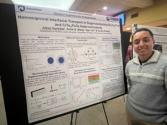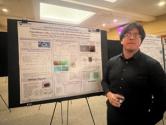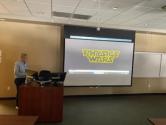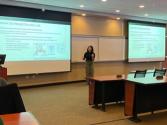SPS Zone Meeting
February 21, 2025 to February 22, 2025
Lewis University, Romeoville, IL
Meeting host: By:James Hofmann
SPS Chapter:

Report of Meeting:
This was a joint conference with the American Physical Society Prairie Section (PSAPS). (https://www.psaps-lewisu.com/).
February 21, 2025:
Registration started Friday afternoon. For those who arrived early, they were able to attend Dr. Jason Keleher’s presentation on ‘Interdisciplinary Nano Science’. The meeting start at 2:45pm with a short Introduction and Welcome presentation by our faculty advisor James Hofmann. The first event was three parallel workshops where students could attend ‘How to create an Elevator Pitch’, ‘Hands-on Exploration of Current AI Tools’, or ‘A Hands-on Introduction to Microscopy’. Afterwards was a buffet dinner and the first plenery presentation presented by Dr. Vipin Chaudhary on ‘The AI Revolution’. Lastly was a poster presentation.
February 22, 2025:
Saturday started with a light breakfast and an opening presentation from Alexis Bibian on his career development at Argonne National Laboratory. Next, Dr. Neil Christensen presented on what to expect when you apply to grad school and when you get there. As well as some common misconceptions about grad school. After a short break, Autumn Crisafulli presented her career development on becoming a nuclear engineer at the Westinghouse Electric Corporation. The final presenter was Dr. Philip Chumbley about an event that he hosts each semester called ‘Physics Wars’. After a short, Star Wars like, video to set the stage, we all went down to the physics classroom to compete in a mini version of the event. There, Dr. Chumbley has prepared seven scientific challenges for our groups to complete. The winner of the competition was decided by who could complete the most challenges in the allotted amount of time. After completing the challenges, we headed back to the presentation room for lunch and Chapter Updates. The meeting was concluded with final remarks by Lewis’s SPS faculty advisor James Hofmann and a group photo was taken.
Agenda:
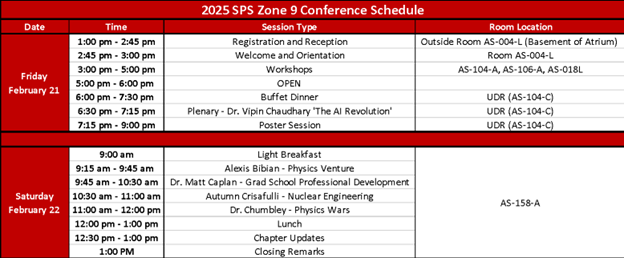
List of Chapters:
Lewis University
Illinois State University (ISU)
DePaul University
Western Illinois University
Washburn University – from Topeka Kansas
Number of Attendees:
31 students registered using the SPS links. There were additional students who registered through the APS links who only attended Friday’s events.
Recommendations for Future Zone Meeting Planning:
- Balance technical talks with interactive sessions (like Physics Wars) to keep attendees involved
- Organize a public outreach event.
- Work on social media presence to document and promote the event.
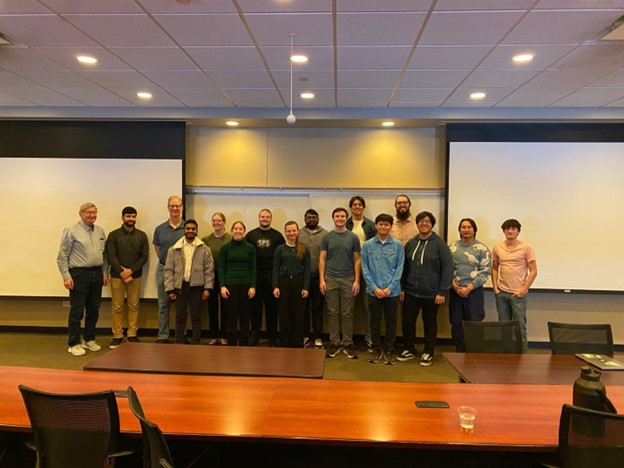
Narrative:
The weekend was a whirlwind of scientific discovery, networking, and friendly competition as Lewis University hosted the SPS Zone 9 meeting in conjunction with the Prairie Section of the American Physical Society (APS). The event, spanning two days, brought together physicists, undergraduate researchers, and science enthusiasts from Illinois, Wisconsin, Iowa, and beyond, fostering an environment where ideas flourished, collaborations were forged, and students glimpsed the exciting possibilities of their futures in physics.
The event kicked off on Friday as students and faculty gathered for the Prairie Section of APS conference. This prestigious gathering allowed undergraduate students the invaluable opportunity to present their research in both talk and poster formats, showcasing their contributions to the field of physics. Beyond student presentations, physicists and professionals from various disciplines shared their ongoing research, broadening the scope of knowledge exchange beyond individual areas of expertise.
Lewis University’s Society of Physics Students (SPS) had a strong presence at the conference, with three of its members—Vice President Ruben Franchini, Emma Teo, and Tom Harless—taking center stage to present their research. Ruben captivated the audience with his work on air quality research. His presentation underscored the importance of air quality awareness and monitoring in regional environments. Meanwhile, Emma Teo and Tom Harless presented research they had been conducting for their Master's degrees, providing fellow attendees with insights into their academic pursuits. Tom’s presentation also served as a practice run for his upcoming thesis defense, offering him an opportunity to refine his delivery in front of an engaged audience. In addition to research presentations, the conference served as a networking hub. One of the highlights was meeting members of DePaul University’s SPS chapter, which was in the process of revitalization. Lewis University’s SPS members enthusiastically shared advice on hosting events, conducting outreach demonstrations, and fostering chapter engagement. To further strengthen ties, the Lewis SPS team offered their new friends a tour of the physics department, showcasing the university’s facilities and research opportunities.
The evening concluded with SPS member Johan Gonzalez presenting research from his summer Research Experience for Undergraduates (REU) at Pennsylvania State University, . These talks highlighted the importance of seeking research opportunities beyond one’s home institution and encouraged attendees to explore similar paths.
Saturday marked the official SPS Zone 9 meeting, a day packed with informative talks, career insights, and hands-on competition. The morning featured two Lewis University alumni, both former SPS members, who returned to share their journeys post-graduation, providing inspiration to the undergraduate audience.
First, Alexis Bibian, who earned both his Bachelor’s and Master’s degrees in Physics from Lewis University, recounted his path to becoming a physicist. His undergraduate research focused on constructing a low-cost, 3D-printed light-scattering device—an endeavor that not only deepened his passion for research but also paved the way for future opportunities. During his studies, Alexis secured a position at Argonne National Laboratory, where he refined his expertise in operating scientific instruments and 3D modeling. Now working full-time at Argonne, he shared valuable insights into transitioning from academia to a professional research career, a particularly relevant topic for many of the soon-to-be-graduating SPS members in attendance. Following Alexis’s talk, Dr. Neil Christensen delivered a compelling presentation titled Grad School Professional Development. His talk debunked common myths about graduate school and shed light on the realities of pursuing a Ph.D. in physics. Dr. Christensen emphasized that graduate school is not an insurmountable challenge but rather an environment with abundant support from faculty and fellow students. His discussion provided reassurance to those considering advanced degrees, breaking down misconceptions and encouraging them to take the next step with confidence. After a brief intermission, Autumn Crisafulli took the stage to share her experiences transitioning from academia to the engineering industry. Now a nuclear safety engineer at Westinghouse Electric Corporation, Autumn detailed her career trajectory and provided practical advice for students interested in applying their physics background to engineering roles. Her talk resonated with many attendees, demonstrating the versatility of a physics degree in diverse professional settings.
The final presentation of the morning came from Dr. Philip Chumbley, who introduced Physics Wars, a long-standing event he hosts each semester. To set the stage, he played an introductory video styled after Star Wars, energizing the crowd for what was to come. Attendees then moved to a physics classroom where Dr. Chumbley had arranged seven scientific challenges. Working in groups, students competed to complete as many challenges as possible within the allotted time, testing their knowledge and problem-solving skills in an engaging, hands-on format. The competition was fierce, but the overarching theme was teamwork and application of physics principles in real-world scenarios.
After the excitement of Physics Wars, attendees reconvened for lunch and an update from Lewis University’s SPS chapter, presented by President Leonardo Ramos. Since hosting the previous Zone 9 meeting in February 2023, the chapter had undertaken numerous initiatives, and Leo was eager to highlight their accomplishments.
One of the standout events was the Pumpkin Pitch, an annual fall tradition where SPS members construct catapults to launch pumpkins provided by community members. The event, which fosters community engagement and scientific curiosity, had seen significant expansion, with three new catapults added to the arsenal, including two smaller trebuchets and a drop catapult capable of launching mini pumpkins great distances. Leo also emphasized the chapter’s dedication to outreach, particularly in local schools, where SPS members demonstrate physics concepts to younger students. One of the most exciting additions to their outreach toolkit was the Rubens’ Tube, an interactive demonstration that visualizes sound waves using flames. This visually captivating experiment had been a hit with audiences, making science more accessible and engaging for younger generations. Additionally, the chapter had participated in the annual Haunted House, an event in which hundreds of Girl Scouts visited Lewis University’s physics department, transformed into a Halloween-themed maze in collaboration with the Chemistry Department. The event provided an entertaining yet educational experience, reinforcing the university’s commitment to community-driven science engagement!
With the final remarks delivered by SPS Faculty Advisor James Hofmann, the event drew to a close. Attendees gathered for a group photo, capturing the camaraderie and shared enthusiasm that had defined the weekend. As students departed, they carried with them newfound knowledge, connections, and motivation to push forward in their scientific journeys.
The SPS Zone 9 meeting at Lewis University was more than just a conference—it was a celebration of physics, community, and the boundless opportunities that lie ahead for those passionate about discovery.

